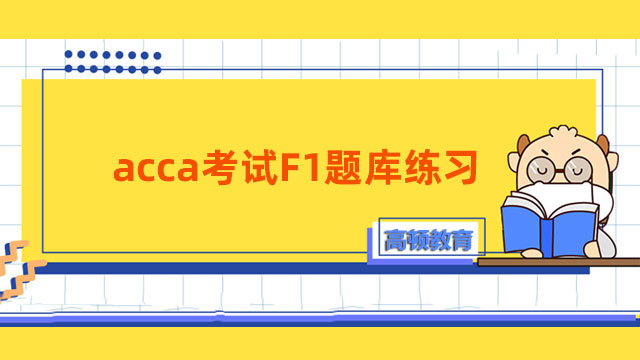ACCA考试P1-P3模拟题及解析7
来源:
高顿网校
2014-07-16
以下是高顿网校小编为学员整理的:ACCA P1-P3模拟题及解析。
Railway Development Company (RDC) was considering two options for a new railway line connecting two towns.
Route A involved cutting a channel through an area designated as being of special scientific importance because it was one of a very few suitable feeding grounds for a colony of endangered birds. The birds were considered to be an important part of the local environment with some potential influences on local ecosystems.
The alternative was Route B which would involve the compulsory purchase and destruction of Eddie Krul’s farm.
Mr Krul was a vocal opponent of the Route B plan. He said that he had a right to stay on the land which had been owned by his family for four generations and which he had developed into a profitable farm. The farm employed a number of local people whose jobs would be lost if Route B went through the house and land. Mr Krul threatened legal action against RDC if Route B was chosen.
An independent legal authority has determined that the compulsory purchase price of Mr Krul’s farm would be $1 million if Route B was chosen. RDC considered this a material cost, over and above other land costs, because the projected net present value (NPV) of cash flows over a ten-year period would be $5 million without buying the farm.
This would reduce the NPV by $1 million if Route B was chosen.
The local government authority had given both routes provisional planning permission and offered no opinion of which it preferred. It supported infrastructure projects such as the new railway line, believing that either route would attract new income and prosperity to the region. It took the view that as an experienced railway builder, RDC would know best which to choose and how to evaluate the two options. Because it was very keen to attract the investment, it left the decision entirely to RDC. RDC selected Route A as the route to build the new line.
A local environmental pressure group, ‘Save the Birds’, was outraged at the decision to choose Route A. It criticized RDC and also the local authority for ignoring the sustainability implications of the decision. It accused the company of profiting at the expense of the environment and threatened to use ‘direct action’ to disrupt the building of the line through the birds’ feeding ground if Route A went ahead.
Required:
(a) Use Tucker’s ‘five question’ model to assess the decision to choose Route A. (10 marks)
(b) Discuss the importance to RDC of recognising all of the stakeholders in a decision such as deciding between Route A and Route B. (8 marks)
(c) Explain what a stakeholder ‘claim’ is, and critically assess the stakeholder claims of Mr Krul, the local government authority and the colony of endangered birds. (7 marks)(25 marks)
Answer:
(a) Tucker and Route A.
Is the decision to choose Route A profitable?
Yes. This will be cheaper for the company (RDC) because it avoids the need to make the compulsory purchase of Mr Krul’s farm. This will save the company $1 million and enable a profit to be made, over 10 years, of $5 million. The equivalent 10-year profit figure for Route B would, accordingly, be $4 million.
Is it legal?
The case says that both routes (A and B) had been given planning permission, so there is no difference between them on matters of legality. Route A is a legally allowable option as it has planning permission from the local government authority.
Is it right?
This depends upon the ethical perspective adopted. Route A would deliver a higher profitability for RDC and also preserve important local social and economic benefits by keeping Mr Krul’s farm. The farm supports local jobs, perhaps has an important role in the local community and, being a farm, provides a source of local food. If these benefits are seen as more important than the future of the birds, then it is right to choose Route A. If the claim of the birds and their impact on the local ecosystem is more important than the profitability of the project and the benefits provided by the farm, then it was wrong to choose Route A.
Is it fair?
This depends upon how the legitimate and reasonable claim of Mr Krul to remain on his land is weighed against the claim of the colony of birds to survive. The choice of Route A ignores the claim of the birds’ right to gain access to their feeding site and because the birds are endangered, it may threaten their future. It is fair to Mr Krul, but unfair to the colony of birds.
Mr Krul, however, employs people who would otherwise lose their jobs, potentially having a negative impact on them and their families. In addition, the farm has been in Mr Krul’s family for four generations and that may also be a relevant factor when considering the fairness of the decision.
Is it sustainable and/or environmentally acceptable?
Route A was probably the less environmentally-sustainable of the two options. Because Route A was chosen, it will mean destroying the important feeding site for the colony of threatened birds. This will threaten the population of these birds and the case suggests that this may represent a threat to the environmental sustainability of local ecosystems. The loss of the feeding ground and the birds may therefore have other unforeseen environmental consequences. Whichever route is chosen,an environmental benefit may accrue because of the replacement of car journeys with increased rail travel.
Summary.
The company chose to prioritise cost-savings and the impact of the farm on the local community over the negative environmental impact that Route A entailed. This may have something to do with Eddie Krul having a louder ‘voice’ than the birds and so more able to express his claim than the voiceless birds (the pressure group did not speak up until after the decision was made). RDC essentially had two choices which would both have had negative effects on some of the stakeholders. It chose to take the decision that was less sustainable but more favourable to shareholders and the stakeholders in the farm.
(b) Importance of recognising all stakeholders.
A decision such as the selection of a new route for a major construction project such as this is bound to create ‘winners’ and ‘losers’. In any project such as this, it is important to identify and recognise the claims of all of the stakeholders for several reasons.
Stakeholder recognition is necessary to gain an understanding of the sources of potential risk and disruption. ‘Save the Birds’,for example, has threatened to disrupt the construction of Route A as it seeks to protect the birds’ feeding ground. Mr Krul,similarly, threatened to bring legal action in the event that Route B was chosen.
Stakeholder recognition is important in terms of assessing the sources of influence over the objectives and outcomes for the project (such as identified in the Mendelow model). Stakeholder influence is assessed in terms of each stakeholder’s power and interest, with higher power and higher interest combining to generate the highest influence. The local government authority, for example, had no view on which was chosen but as a high power stakeholder (capable of granting or withholding legal permission), it could have been very influential had it expressed a view either way.
Stakeholder recognition is necessary in order to identify potential areas of conflict and tension between stakeholders,especially relevant when it is likely that stakeholders of influence will be in disagreement over the outcomes. A survey of the stakeholders in a rail-building project such as this, once mapped in terms of influence, would signal which stakeholders are likely to cause delays and paralysis by disagreement and whose claims can then be studied for ways to reduce disagreement.
There is an ethical and reputational case for knowledge of how decisions affect stakeholders, both inside the organisation or external to it. Society can withdraw its support from organisations that it perceives as unethical or arrogant. This can affect organisational performance by reducing their reputations as employers and suppliers of future services. RDC may acquire a reputation for environmental damage and this could mean they lose public trust on future projects of this type. A ‘deep green’ perspective would take an unfavourable view of companies that failed to recognise some stakeholder claims.
(c) Stakeholder claims.
Stakeholder claim
A stakeholder is any person or entity that can affect or be affected by the actions or policies of an organisation. In the case of RDC, two ‘affected’ stakeholders are Eddie Krul and the colony of endangered birds. The local government authority is both affected by the decision and can also have an influence over the decision. A claim is the outcome sought or the outcome that would most benefit or do least harm to a given stakeholder. It is what that particular stakeholder ‘wants’ or would want, if it were able to understand and voice its claim.Assessment of the claims
Mr Krul was seeking to maintain his house and land by getting RDC to choose Route A. His claim is based partly on his family having been on the same land for four generations and that he employs a number of local people. As a ‘vocal’ critic,he is able to clearly articulate his views and lobby for his preferred option. He clearly understands what would happen to him if Route B was chosen and can clearly voice that concern to decision-makers.
The only concerns of the local government authority were making sure the investment went ahead with the benefits it believed would accrue to the local region. Its claim is to ensure that the investment and jobs are attracted and in pursuit of that, takes no view on the competing claims of Mr Krul and the colony of birds. It could be criticised for being passive in this decision and for assuming that RDC could evaluate such a decision adequately themselves, in both economic and ethical terms.
The colony of birds is ostensibly a voiceless stakeholder, although it does now have ‘Save the Birds’ claiming to speak on its behalf. The bird colony does not understand that its feeding ground is threatened but it will incur material loss when Route A is developed. Because it does not have an effective voice (other than the ‘outrage’ of ‘Save the Birds’ after the decision
was taken), it was unable to contribute to the debate over the choice of route. The local government authority did not prioritise one stakeholder over the other when granting RDC permission to develop either route.
高顿网校小编寄语:自信是成功的先决条件。

扫一扫微信,*9时间获取2014年ACCA考试报名时间和考试时间提醒
高顿网校特别提醒:已经报名2014年ACCA考试的考生可按照复习计划有效进行!另外,高顿网校2014年ACCA考试辅导高清课程已经开通,通过针对性地讲解、训练、答疑、模考,对学习过程进行全程跟踪、分析、指导,可以帮助考生全面提升备考效果。
报考指南:2014年ACCA考试备考指南
免费题库:2014年ACCA考试免费题库
考前冲刺:ACCA备考秘籍
高清网课:ACCA考试网络课程
报考指南:2014年ACCA考试备考指南
免费题库:2014年ACCA考试免费题库
考前冲刺:ACCA备考秘籍
高清网课:ACCA考试网络课程
版权声明:本条内容自发布之日起,有效期为一个月。凡本网站注明“来源高顿教育”或“来源高顿网校”或“来源高顿”的所有作品,均为本网站合法拥有版权的作品,未经本网站授权,任何媒体、网站、个人不得转载、链接、转帖或以其他方式使用。
经本网站合法授权的,应在授权范围内使用,且使用时必须注明“来源高顿教育”或“来源高顿网校”或“来源高顿”,并不得对作品中出现的“高顿”字样进行删减、替换等。违反上述声明者,本网站将依法追究其法律责任。
本网站的部分资料转载自互联网,均尽力标明作者和出处。本网站转载的目的在于传递更多信息,并不意味着赞同其观点或证实其描述,本网站不对其真实性负责。
如您认为本网站刊载作品涉及版权等问题,请与本网站联系(邮箱fawu@gaodun.com,电话:021-31587497),本网站核实确认后会尽快予以处理。
点一下领资料
【整理版】ACCA各科目历年真题
真题高频考点,刷题全靠这份资料
下载合集
acca全科学习思维导图
梳理核心考点,一图看懂全部章节
下载合集
2023年acca考纲解析
覆盖科目重难点,备考按照计划走
下载合集
acca备考 热门问题解答
- acca考试怎么搭配科目?
-
建议优先选择相关联的科目进行搭配报考,这样可以提高备考效率,减轻备考压力,1、F1-F4:为随时机考科目,难度较低,这里可以自行随意选择考试顺序。2、F5-F9:如果你的工作的和财务会计或者审计有关、或者你比较擅长财务和审计的话,推荐先考F7和F8。你可以选择一起考ACCA考试科目F7和F8或者先考F7(8)再考F8(7),这就要取决你一次想考几门。3、P阶段:选修科目中,建议企业首选AFM!第二部分科目进行选择,如果AA和SBR掌握学生更好,可以通过选择AAA,如果SBL掌握的好,可以自己选择APM。
- acca一共几门几年考完?
-
acca一共有15门考试科目,其中有必修科目和选修科目,考生需要考完13门科目才能拿下证书。
- acca一年考几次?
-
acca一年有4次考试,分别是3月、6月、9月和12月,分季机考科目是采取的这类四个考季的模式,而随时机考则是没有这方面的时间规定限制,可以随报随考。
- acca的含金量如何?
-
ACCA证书的含金量是比较高的,从就业、能力提升、全球认可等角度来说,都是比较有优势的证书,其含金量主要表现在以下几个方面:1、国际化,认可度高;2、岗位多,就业前景好;3、缺口大,人才激励。
严选名师 全流程服务
其他人还搜了
热门推荐
-
acca考试F1题库练习,考生必备! 2023-03-20
-
acca2022真题下载流程介绍,必做考前模考题! 2023-02-24
-
ACCA试卷出题形式?ACCA考试最快多久能通过? 2021-07-24
-
ACCA官方样题 F4(ENG) F8 2021-01-07
-
ACCA考试P1-P3模拟题及解析9 2021-01-07
-
四大会计事务所2017年终精华会评(中) 2018-02-01
-
2016年ACCA F1模拟练习题及答案 2016-02-29
-
2016年ACCA F8每日一练:Professional ethics 2016-01-26
-
2016ACCA考试F8自测题:Corporate governance 2016-01-26
-
关于ACCA考试P7中的专业和道德问题 2015-11-24
-
ACCA P5精选模拟题之战略性绩效考核 2015-10-10
-
ACCA F9模拟测试题之投资评估 2015-10-10
-
ACCA P3精选练习题之战略管理和组织变革 2015-10-10
-
2014年ACCA《公司法与商法》真题及答案七 2015-07-20
-
2014年ACCA《公司法与商法》真题及答案七 2015-07-20
-
2014年ACCA《公司法与商法》真题及答案六 2015-07-20
-
2014年ACCA《公司法与商法》真题及答案五 2015-07-20
-
2014年ACCA《公司法与商法》真题及答案四 2015-07-20
-
2014年ACCA《公司法与商法》真题及答案三 2015-07-20
-
2014年ACCA《公司法与商法》真题及答案二 2015-07-20
-
2014年ACCA《公司法与商法》真题及答案一 2015-07-20
-
2014年ACCA《公司法与商法》真题及答案八 2015-07-20
-
2015年ACCA考试模拟题 2015-06-26
-
2015年ACCA考试精选测试题汇总 2015-06-19
-
2015年ACCA考试《财务成本管理》模拟题汇总 2015-06-18
-
2015年ACCA考试F8模拟试题:Financial Management 2015-06-18
-
ACCA考试2015年《财务成本管理》模拟练习汇总 2015-04-27
-
ACCA考试2015年《财务成本管理》模拟练习5 2015-04-27
-
ACCA考试2015年《财务成本管理》模拟练习4 2015-04-27
 更多服务
更多服务

















